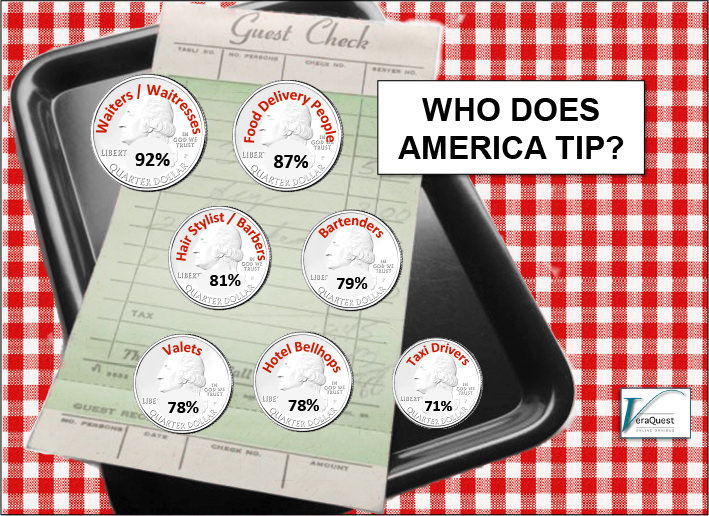My wife and I were out having dinner with friends a few weeks back and it was decided we’d split the check. I asked my friend about the tip, he suggested an amount and that was that. However, the moment had the potential to be somewhat “Seinfeld-esque” had we disagreed on the amount. Let’s face it, who wants to look like a “putz” – as Jerry might say – by leaving less of a tip than one’s dining companions when the check is being split equally.
Tipping in America can be perplexing particularly for foreigners. So much so that folks like the BBC have felt the need to publish guides for traveling Brits. One guide includes such charming questions as “Am I legally required to tip?” Those coming from abroad are easily confused about what’s customary, as tipping isn’t nearly as ubiquitous abroad as it is here in the US.
With that in mind, VeraQuest thought it might be fun to see how Americans might respond to a few questions about tipping, specifically which service professions are most likely to receive a tip. The following results are from a representative sample 1,469 U.S. respondents surveyed in January, 2016.
Not surprisingly, the vast majority of Americans (92%) say they tip waiters and waitresses which begs the question “who are the 8% that don’t”. Perhaps they’re people who rarely go out to eat. Servers are followed by people in the food delivery profession (87%); hair-stylists/barbers (81%); bartenders (79%) valets and bellhops (78%). Amazingly, only 71% of Americans tip taxi drivers. Warning: not tipping a cabbie in NYC could be hazardous to your health.
While we don’t see vast differences across demographic groups, we do see some items that caught our attention:
- When it comes to tipping waiters and waitresses for example, those earning $35K – $50K are significantly more likely to tip than those who earn $100K or more (96% vs. 90%). Is that because people in the $35K – $50K range are more likely to be in the service industry themselves? Putting aside statistics for moment, those earning $100K or more are indeed the income group least likely to tip servers overall. Why do I find that so disturbing?
- Virtually every individual aged 65 and over in our survey (99%) report tipping waiters and waitresses, compared to only 83% of those in the 30 – 39 age bracket. In fact, seniors tend to be better tippers across all service professions.
- There’s virtually no difference by gender across most service professions though women are considerably more likely to tip their hair-stylist than men. (85% vs. 76%). Completely understandable…particularly if you’re familiar with the 1975 movie Shampoo.
- Those families without children 18 or younger living at home are substantially more likely to be tippers, irrespective of the type of service. It would seem this fact is driven more by age than by income because as we’ve seen – having a higher income doesn’t translate into being more likely to tip.
- And finally Caucasians appear to be about 10 percentage points more likely than Hispanics or Blacks (not Hispanic) to tip waiters/waitresses, food delivery people, hair stylists/barbers, valets, bellhops, and taxi drivers. On the other hand, Hispanics are more likely than Caucasians or Blacks to tip hotel housekeepers, hotel concierges, baristas, restroom attendants and home repairmen/handymen.
What do you think?
We’d love to hear what you think: Do you tip? How much do you generally tip? And more importantly, when and why do you choose to not tip?

 Bob says
Bob says
March 9, 2016 at 11:44 amPeter it is very interesting. a couple of categories omitted ie…dealers, manicurists, gas station attendants (NJ)
it would seem valuable to quantify the rates of tipping in addition to the frequency. Are the 1469 respondents fairly spread across the nation or weighted towards a specific region?
 Peter Gold says
Peter Gold says
March 9, 2016 at 2:59 pmHi Bob,
Thanks for your comment. We had 13 services listed on the survey but didn’t include them all in the post…for fear it would make for a boring post. We did include gas station attendants though. They came in at 27%.
As a poker player and casino BJ player, I undertand why dealers could have made the cut, though they may have constituted too narrow a population for the purposes of our post. . Manicurists certainly would have been a good one to add.
Our surveys are nationally representative. we quota sample and balance across six criteria: age, gender, region, income, education and ethnicity. If you want to send me an email address, I can send you more information about our surveys. You can email me at peter.gold@veraquestresearch.com.